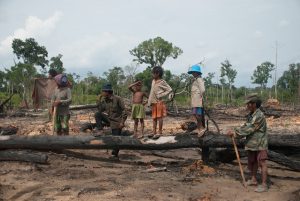C0ntinued illegal logging in Cambodia’s protected areas is threatening the livelihoods of indigenous peoples and threatening their cultural identity, the rights group Amnesty International said in a new report published on Friday.
The report focuses on the impacts of deforestation on the Kuy people, one of the largest of Cambodia’s 24 indigenous minority groups, and the Prey Lang and Prey Preah Roka protected forest sanctuaries that are central to their economic, cultural, and spiritual life. Amnesty cited remote sensing data showing that at least 6,200 hectares of forest were cut down in these two protected areas in 2021, after more than a decade of severe forest loss.
“In Cambodia, the cultural and spiritual identity of the Kuy people is intimately intertwined with protected forests such as Prey Lang and Prey Preah Roka,” stated the report, which was based on interviews with 20 community activists working to protect the two forests. “In addition to their cultural practices and spiritual beliefs, the traditional livelihoods of Kuy people depend on the sustainable use of the forests which they rely upon.”
In particular, many Kuy practice rotating slash-and-burn agriculture and harvest forest products like vines, rattan, and liquid tree resin, a valuable product which is used for waterproofing wooden boats and making paints and varnishes.
One Kuy villager who gave the name Chan Thyda told Amnesty researchers that over the past few years, Prey Preah Roka had lost about 70 percent of its resin trees, which are prized by loggers because they are hard woods that are highly suitable for furniture production “Many people from outside … come and steal our trees when we are not in the forest – especially during the rice season when we are planting saplings or harvesting rice.” On one day, Thyda said, “30 or 40 resin trees will be cut.”
Kuy communities also rely on the forests to maintain spiritual and cultural practices; ancestral burial grounds located within the forests and specific locations believed to be inhabited by forest spirits. As another Kuy resident told Amnesty, “We have lost so many traditions and places that are sacred to us.”
Despite several decades of government promises to tackle illegal logging, Cambodia has lost about 64 percent of its tree cover since 2011, according to Amnesty – one of the highest rates of deforestation in the world. And over the last 15 years, Prey Lang has been a particular target. A 2020 report found that Prey Lang, which spans about 430,000 hectares across Kratie, Stung Treng, Kampong Thom, and Preah Vihear provinces in north-central Cambodia, had lost more than 100,000 hectares of forest between 2000 and 2019. As one member of the Prey Lang Community Network (PLCN) told me when I visited the sanctuary in 2013, “they cut trees night and day.”
After a long campaign by civil society groups including PLCN, the government designated Prey Lang a protected area in 2016, but the change in legal status has seemingly done little to stem the felling of trees. The reason is that revenues from logging are inextricably bound up with Cambodia’s political economy, in which the granting of preferential access to natural resources is a time-tested means of securing and renewing the political loyalty of sectional powerbrokers.
Illegal logging has been a crucial source of income for Cambodia’s ruling elite since the 1990s, and has played an important role in promoting elite cohesion. In a landmark 2007 report, the advocacy group Global Witness documented the involvement of senior Cambodian officials, including relatives of Prime Minister Hun Sen, in logging operations, which were often conducted “under the guise of legally dubious plantation developments and harvesting permits.”
As such, the Amnesty report recapitulates conclusions that have become deadeningly familiar to Cambodia watchers. As it points out, the sorry situation in Prey Lang and Prey Preah Roka is the result of more than simply a lack of enforcement capacity: “In many cases, the same government officers who are charged with protecting these precious forests are instead profiting from their destruction. Embedded corruption in Cambodia’s Ministry of Environment and within the police is fueling the illegal logging trade and posing an existential risk to some of Cambodia’s most important remaining forests.”
As the report notes, the government has come down hard on anyone seeking to disrupt the workings of this extractive political economy in and around Prey Lang. In February 2020, the report notes, PLCN activists and other environmental defenders were barred from entering Prey Lang and Prey Preah Roka, removing one of the few checks on the activities of loggers and concessionaires within the area. This followed the arrest earlier that month of five environmental activists inside Prey Lang.
All of these actions send the message that whatever its promises, the Cambodian government has no real interest in stemming the flow of the revenues from logging, ensuring that communities like the Kuy will remain in a state of siege for the foreseeable future.

































